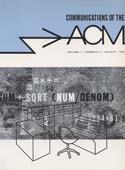August 1964 - Vol. 7 No. 8

Features
A simple automatic derivative evaluation program
A procedure for automatic evaluation of total/partial derivatives of arbitrary algebraic functions is presented. The technique permits computation of numerical values of derivatives without developing analytical expressions for the derivatives. The key to the method is the decomposition of the given function, by introduction of intermediate variables, into a series of elementary functional steps. A library of elementary function subroutines is provided for the automatic evaluation and differentiation of these new variables. The final step in this process produces the desired function's derivative.
The main feature of this approach is its simplicity. It can be used as a quick-reaction tool where the derivation of analytical derivatives is laborious and also as a debugging tool for programs which contain derivatives.
Investigation of a new analytical method for numerical derivative evaluation
A recently proposed analytical approach to numerical derivative evaluation is discussed. The technique is shown to be both accurate and easy to apply, though certain indicated modifications are required. Its use should greatly facilitate the writing and debugging of programs requiring derivatives of highly complex functions.
To increase reliability of transmission between magnetic tape and core storage on an IBM 7090/7094, blocks or records of data are often assigned a word called a logical checksum. This is a number derived from the block by some simple algorithm and as unique to it as possible. The method most commonly used to form a checksum is to add together every datum in the block by the ACL (add and carry logical) instruction.
Divide-and-correct methods for multiple precision division
A division problem is defined and notation to relate it to the problem of multiple precision operation in a digital computer is introduced. A basic divide-and-correct method for multiple precision division is formulated and its known properties briefly reviewed. Of particular interest is the fact that the method produces at each step a set of precisely three estimates for the desired result, one of which is exact.
A method of syntax-checking ALGOL 60
A syntax checker was designed based on the syntax of ALGOL as described in the ALGOL 60 Report [Communications of the ACM, May 1960]. Since the definition of the elements of the language is recursive it seemed most desirable to design the syntax checker as a set of mutually recursive processors tied together by subroutines which perform certain bookkeeping functions. Because of the recursive nature of the language and of the syntax checker the problem of recovery after an error required much attention. A method was devised which permits most programs to be checked completely despite errors.
A note on the formation of free list
The concept of an available-space list was introduced by Newell and Shaw [1] in 1957, and has since been incorporated into a number of different systems [2-5]. The available-space list (or “free list”) is a list of all available memory locations. It should initially be as large as possible, and ideally it would contain every cell not used by the program. The subject of this note is the initial formation of a free list on the IBM 7090-7094, using the FORTRAN II monitor, version 2. The method presented originated while the authors were working on an implementation of the WISP [5] system for the 7090 in cooperation with Prof. M. V. Wilkes and his colleagues.
Remark on algorithm 162: Near-minimax polynomial approximations and partitioning of intervals
A method of near-minimax polynomial approximation is described. As a by-product, this method provides a formula for an estimate of the maximum error associated with a given degree of approximation. Using this formula, a partitioning algorithm is obtained for dividing a basic interval into sub-intervals for which approximations of equal degree give equal maximum error.
Machine controls for analysis of variance
A major problem in using the analysis of variance, as the number of factors increases, is the exponential rise in the number of interactions. Even though the experimenter may not be interested in these interactions it is impossible to ignore them in most experimental designs because of the problem of getting error terms.
It is natural therefore to look to the computer to handle the bulk of work involved in computing the interactions. A program device to get the computer to do this is described.
A method for scheduling final examinations to yield a minimal number of student conflicts is described. The “minimization” is achieved by repetitively evaluating a nonlinear set of equations. Imbedded in the process is a random or Monte Carlo selection of assignments. As in such heuristic techniques, the solution may not be optimum and many solutions may be found which yield locally minimal results. Computer programs are described and empirical results given.
Automatic syntactic analysis has recently become important for both natural language data processing and syntax-directed compilers. A formal parsing system G = (V, &mgr;, T, R) consists of two finite disjoint vocabularies, V and T, a many-many map, &mgr;, from V onto T, and a recursive set R of strings in T called syntactic sentence classes. Every program for automatic syntactic analysis determines a formal parsing system.
A directed production analyzer (I, T, X, &rgr;) is a nondeterministic pushdown-store machine with internal vocabulary I, input vocabulary T, and all productions of &rgr; in the form: (Z, a) → aY1 ··· Ym, Z, Yi &egr; I, a &egr; T. Every context-free language can be analyzed by a directed production analyzer.



